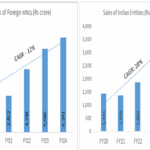The report is focused on the detection of urinary iodine levels in non-iodized salt against iodized salt consumers
Author: Dr. Himmatrao Saluba Bawaskar is an Indian physician from Mahad, Maharashtra who has been published in “The International Journal of Clinical Practice”. He is well known for his research on treatment for scorpion poisoning
India
healthysoch
Chandigarh, June 08, 2020 :
Dr. H S Bawaskar
 The incidence of thyroid dysfunctions including hypothyroidism has been on an upward trajectory in India and the change in numbers is significant. In Mahad, the incidence of hypothyroidism has significantly increased from a reported rate of 1.5% (total cases 11) between the years 1990 and 2002 to 66.9% (total cases 482) between the years 2015 and 2019. Dr. H S Bawaskar said, “ Our report is focused on the detection of urinary iodine levels in non-iodized salt against iodized salt consumers and also in the correlation of thyroid dysfunction accompanied with raised thyroid-stimulating hormone (TSH) levels, thyroxin peroxidase antibody (TPOAB) levels and their association with diabetes mellitus (DM), hypertension (HTN) and ischemic heart disease (IHD) in rural India.” The universal iodization program was started in 1989 in India. More than adequate iodine supplementation in a region with adequate iodine content in the diet leads to hypothyroidism and immune thyroiditis. Dr. Bawaskar said, “We undertook this direct observational study to explore whether there is a difference in thyroid dysfunction, TSH, TPOAB levels and urinary Iodine excretion among persons residing in a village, who consume non-iodinated raw salt (group A), and those from Mahad town, who consume iodized salt (group B). We analyzed clinical manifestations of thyroid dysfunctions, hypertension, and diabetes mellitus (DM).”
The incidence of thyroid dysfunctions including hypothyroidism has been on an upward trajectory in India and the change in numbers is significant. In Mahad, the incidence of hypothyroidism has significantly increased from a reported rate of 1.5% (total cases 11) between the years 1990 and 2002 to 66.9% (total cases 482) between the years 2015 and 2019. Dr. H S Bawaskar said, “ Our report is focused on the detection of urinary iodine levels in non-iodized salt against iodized salt consumers and also in the correlation of thyroid dysfunction accompanied with raised thyroid-stimulating hormone (TSH) levels, thyroxin peroxidase antibody (TPOAB) levels and their association with diabetes mellitus (DM), hypertension (HTN) and ischemic heart disease (IHD) in rural India.” The universal iodization program was started in 1989 in India. More than adequate iodine supplementation in a region with adequate iodine content in the diet leads to hypothyroidism and immune thyroiditis. Dr. Bawaskar said, “We undertook this direct observational study to explore whether there is a difference in thyroid dysfunction, TSH, TPOAB levels and urinary Iodine excretion among persons residing in a village, who consume non-iodinated raw salt (group A), and those from Mahad town, who consume iodized salt (group B). We analyzed clinical manifestations of thyroid dysfunctions, hypertension, and diabetes mellitus (DM).”
Dr. Bawaskar said, “We compared TSH, TPOAB levels, and urinary iodine excretion (UIE) in iodized salt consumers (group B) and non-iodized salt consumers (group A). The population of group-A is from a village where most of the residents fall below the poverty line and, therefore, prefer non-iodized salt, which is five times cheaper than iodized salt. Three milliliters of blood was collected in sterile plain glass tubes and transferred to a laboratory at Mahad, for estimation of TSH and TPOAB by ELFA.”
Also, a random collection of urine for analysis of iodine was carried out separately from 15 persons belonging to each group; nearly 50 mL of urine was analyzed in each case. Quantification of iodine content in urine samples, raw and iodinated salts were done at Amrita Institute of Medical Sciences and Research Center located at Kochi, Kerala.
Between January 2018 and December 2019, among a total of 725 participants, 409 (M191: F218) were investigated, of these 152 were from group A, and 277 subjects were from group B. They were investigated for TSH, TPOAB levels and iodine excretion in urine, diabetes, hypertension, and ischemic heart disease.
The cut-off for normal TSH level was determined as all values below 5 and the statistics revealed that in group A versus B, the numbers stood at 151 (99.3%) versus 201 (78.2%). The numbers for more than normal TSH levels (>5.01+) stood at 1 (0.7%) versus 56 (21.8%) (P-value < .001) respectively. The cut-off for normal TPOAB levels was determined as all values equal to or below 5.6 and the statistics revealed that in group A versus group B, the numbers stood as 152 (100%) versus 208 (80.9%). For all those people whose results were consistent with raised TPOAB levels (>5.6), the numbers stood at 0 (0.0%) versus 49 (20.1%) (P-value < .001) respectively. It was found that the proportion of persons with hypertension, diabetes and ischemic heart disease was lower within control group A. Median urinary iodine excretion levels in the iodinated group was 75.8 (IQR—56.2 to 83.3), and in the non-iodinated group was 73.5 (IQR—27.4 to 88.2), this difference was not statistically significant (P = .451).


In China, post-universal salt iodination, the prevalence of hyperthyroidism, overt hypothyroidism, and autoimmune thyroiditis were recorded as 0.5%, 1.7%, and 2.8% respectively.3 A significantly upwards trend in TPOAB positivity was reported by large-scale epidemiological studies, conducted in eight major cities of India.4 In India, salt is iodinated by potassium iodide (KI) or potassium iodate (KIO3). The reduction in thyroid hormones in a background of high iodine concentration is called the “Wolff–Chaikoff effect.”
Reports from Brazil, Denmark, Italy, and China have highlighted the harmful effects of long-term iodine consumption.3,5,6 Long-standing exposure to excessive iodine, from ill-monitored iodinated salt intake and water supply, are risk factors of hypothyroidism. We undertook this direct observational study to explore whether there is a difference in thyroid dysfunction. We observed an increase in the prevalence of hypothyroidism, subclinical hypothyroidism, raised TPOAB in asymptomatic cases, with a significant rise in the metabolic and cardiovascular diseases in iodinated salt consumers as compared with non-iodinated salt consumers (<0.001). This report goes against the statement of Zimmermann et al that the small risk of iodine excess is far outweighed by the substantial risk of iodine deficiency.7
Most of the iodide found in seawater is oxidized to form elemental iodine. Iodine evaporates into the atmosphere and is returned to the soil by rain. The mountainous, hilly areas have frequent flooding with heavy rain. The iodine cycle is slow and the soil and crops are deficient of iodine, so is the food of these regions.7,8 Iodide form of iodine, which is naturally present in raw or non-iodized salt, is almost completely and rapidly absorbed in the stomach and duodenum vis-a-vis iodinated salt which is widely used in iodization of table salt; it is reduced in the gut and then absorbed as iodide. Organically bound natural iodine is typically digested, and then released iodide is absorbed. The iodine content of various iodized salts available in the market is >30 ppm, while raw salt content is <15 ppm. |
The daily requirement of iodine is met by a balanced diet and drinking water, except in hilly regions and around the rivers and great lakes where iodine has been leached out of soil so that the crops grown in these iodine-deficient lands have insufficient iodine and results in an increased incidence of hypothyroidism. The areas with heavy rainfall or snowfall are particularly likely to be iodine-deficient as the iodine content of the superficial layer of soil is washed away.
In this study, 21.8% people had TSH > 5.01, as compared to 0.7% (P < .001) in the non-iodised salt population. Similar to the prospective study from Denmark before and after iodine supplement, there was a moderate increase in the incidence of overt hypothyroidism (relative risk 1.35; 95% CI 1.11-1.66).6 The present report reveals increased thyroid dysfunction in the population consuming iodized salt (Table 1).
Sustained salt iodization programs are beneficial in the regions where there is a deficiency of iodine in food and water. Universal iodization of salt in this non-goiter endemic state resulted in a higher incidence of thyroid dysfunctions, which further added increased monetary expenses towards multiple investigations and treatment.
The incidence of thyroid dysfunction and TPOAB is (P < .001) significant in iodized salt consumers. In a population of raw salt consumers, the naturally occurring iodine is non-antigenic and is less likely to induce thyroiditis and subsequent thyroid dysfunction, as seen in the present report of raw salt consumers. With the shift in a population suffering from mild deficiency to instead optimum or excessive iodine intake, the incidence of autoimmune hypothyroidism has been increasing.9 Iodine alters thyroxin peroxides in such a way that it makes them more antigenic.10 1
Although the iodine content of raw salt is below the normal requirement (<15 ppm), the incidence of thyroid dysfunctions is insignificant as compared with that seen in iodized salt from the market (>30 ppm). However, the difference in urinary iodine levels is insignificant between these two groups. The Government of India and endocrinologists should review the concept of prevention of thyroid dysfunction by the iodination of edible salt in a region without goiter, like the state of Maharashtra.
Dr. H S Bawaskar, Bawaskar Hospital and Clinical Research Center, Maharashtra. India.
Email: himmatbawaskar@rediffmail.com
healthysoch







